A crochet stitches PDF is a valuable resource for crafters, offering step-by-step guides to mastering essential stitches. From basic to advanced techniques, these guides provide clear instructions and visuals, making it easy to learn and practice crochet stitches effectively. Perfect for beginners and experienced crocheters alike, a PDF guide ensures you can create beautiful projects with confidence and precision.
Overview of Crochet and Its Popularity
Crochet has become a beloved craft worldwide, offering versatility and creativity for makers of all skill levels. Its popularity stems from its accessibility—simple tools and yarn are all you need to create beautiful, functional items. From cozy blankets to stylish clothing, crochet allows for endless possibilities. The rise of free crochet patterns and tutorials, especially in PDF formats, has made it easier for beginners to learn and for experienced crafters to explore new techniques. This accessibility, combined with the therapeutic benefits of crochet, has contributed to its growing popularity as a hobby and artistic expression.
Importance of Learning Crochet Stitches
Mastering crochet stitches is essential for creating diverse and intricate designs. Each stitch serves as a building block, allowing crafters to explore various patterns and projects. Learning stitches enhances creativity, problem-solving skills, and hand-eye coordination. It also builds confidence, as seeing a project come to life is incredibly rewarding. Whether making gifts, home decor, or personal items, understanding stitches opens endless possibilities. Crochet stitches PDF guides provide a structured way to learn, ensuring clarity and progression. This knowledge not only improves practical skills but also fosters a sense of accomplishment and artistic expression.
Benefits of Using PDF Guides for Crochet Stitches
Crochet stitches PDF guides offer unparalleled convenience and accessibility. They provide clear, visual instructions that can be easily zoomed in for detail. PDFs are portable, allowing crafters to take patterns on-the-go without bulky books. Many guides are free or low-cost, making them budget-friendly. They also save space, as they can be stored digitally. Additionally, PDFs often include step-by-step tutorials and high-quality images, ensuring better understanding. This format is ideal for beginners and experienced crocheters alike, offering a structured and organized way to master various stitches and techniques efficiently.
Essential Crochet Stitches for Beginners
Mastering basic stitches like the chain, single crochet, half double crochet, and double crochet forms the foundation for all crochet projects, helping beginners build confidence and skill.
Chain Stitch (Foundation of Crochet)
The chain stitch is the fundamental starting point for most crochet projects. It creates a series of connected loops that form the base of your work. To make a chain stitch, insert the crochet hook, yarn over, and pull through to create the first loop. Repeat this process, drawing yarn through the previous loop each time, until your chain reaches the desired length. This stitch is versatile and essential for beginners, as it sets the stage for more complex stitches. Practice the chain stitch to ensure even tension, as it directly affects the consistency of your crochet work. Refer to your crochet stitches PDF for step-by-step visuals and instructions to master this foundational skill.
Single Crochet (SC)
The single crochet (SC) is one of the most common and versatile stitches in crochet. It is typically worked into the chain stitch foundation. To create an SC, insert the hook into the stitch, yarn over, draw up a loop, yarn over again, and pull through both loops on the hook. This stitch creates a soft, fabric-like texture and is ideal for beginners. It is widely used in garments, blankets, and home decor projects. The SC stitch is a great way to practice even tension and stitch consistency. Refer to your crochet stitches PDF for clear step-by-step instructions and visuals to master this essential stitch.
Half Double Crochet (HDC)
The half double crochet (HDC) is a stitch that creates a fabric slightly taller than the single crochet but shorter than the double crochet. It is worked by yarning over, inserting the hook into the stitch, yarning over again, drawing up a loop, yarning over once more, and pulling through all three loops on the hook. This stitch is versatile and ideal for projects requiring a bit more texture, such as sweaters, scarves, and blankets. The HDC stitch is easy to learn for beginners and works up quickly, making it a popular choice for many crocheters. Your crochet stitches PDF will provide detailed visuals and instructions to help you master the HDC stitch seamlessly.
Double Crochet (DC)
The double crochet (DC) stitch is a fundamental crochet stitch that creates a taller fabric compared to the single and half double crochet. It involves yarning over, inserting the hook into the stitch, yarning over again, drawing up a loop, yarning over once more, and pulling through all three loops on the hook. This stitch is excellent for projects requiring more texture and drape, such as afghans or garments. As an easy stitch for beginners, the DC works up quickly, making it a favorite among crocheters. Your crochet stitches PDF will offer clear instructions and visuals to help you master the DC stitch efficiently.
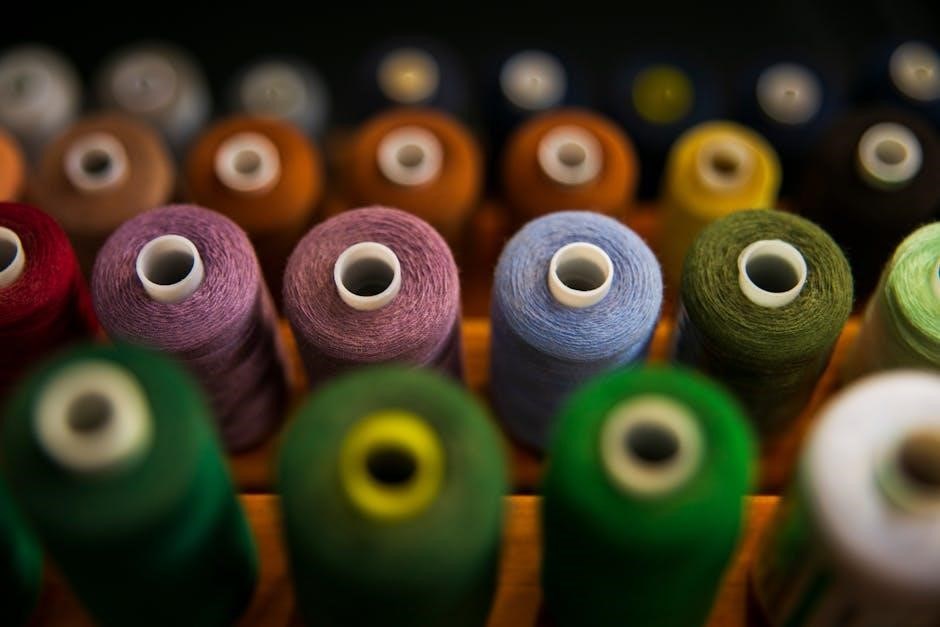
Intermediate Crochet Stitches
Intermediate stitches build on basic skills, offering versatility for more complex projects. They introduce techniques like texture, cables, and reversible patterns, ideal for blankets, clothing, and home decor.
Slip Stitch (SL ST)
The slip stitch (SL ST) is a fundamental crochet stitch used to join two pieces of crochet work seamlessly or to shape garments. It is nearly invisible in finished projects, making it ideal for closing rounds or sewing seams. To work a slip stitch, insert the crochet hook into the specified stitch, yarn over, and pull the yarn through both the stitch and the loop on the hook. This stitch is essential for creating a clean finish and is often used in patterns like amigurumi toys, hats, and sleeves. Practicing the slip stitch ensures a smooth, professional-looking join. Additionally, it can be used to weave in ends or join new yarn seamlessly. Mastering the slip stitch is a key skill for intermediate crocheters, enhancing the overall quality of their projects.
Stitch Increases and Decreases
Stitch increases and decreases are essential techniques for shaping crochet projects, such as sweaters, hats, and amigurumi toys. Increases involve creating additional stitches to widen a project, often by working multiple stitches in one. Decreases reduce the number of stitches, typically by working two or more stitches together. Common methods include the half double crochet increase (hdc) and the single crochet decrease (sc2tog). Properly managing increases and decreases ensures a smooth, even shape. Practice these techniques to master patterns requiring shaping, and always count stitches to maintain consistency and avoid errors in your crochet projects.
Herringbone Stitch
The Herringbone Stitch creates a reversible fabric with a subtle chevron pattern, resembling the herringbone design seen in knitting. It is an intermediate stitch that adds visual interest to projects like scarves, blankets, and clothing. To crochet the Herringbone Stitch, work alternating front and back post stitches, creating a textured, zigzag effect. This stitch is versatile and works well with various yarns, though smooth yarns showcase the pattern best. Maintaining even tension is crucial to prevent puckering. Practice on a swatch to master the technique before incorporating it into larger projects for a professional finish.
Moss Stitch (Granite Stitch)
The Moss Stitch, also known as the Granite Stitch, is a reversible crochet stitch that creates a subtle, textured fabric. It works up quickly and is perfect for projects like scarves, blankets, and home decor. The stitch pattern involves working single crochet stitches in a specific sequence, alternating between working in the front and back loops of the stitches. This creates a fabric with a soft, moss-like appearance. The Moss Stitch is versatile and works well with variegated yarns, adding visual interest without being overwhelming. It’s a great choice for intermediate crocheters looking to expand their stitch library.
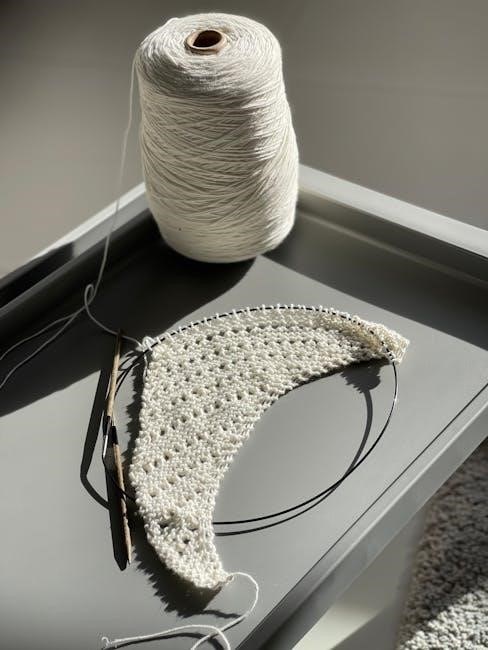
Advanced Crochet Stitches
Advanced Crochet Stitches offer intricate patterns for experienced crafters. Techniques like cables, shells, and lace create complex, visually appealing designs. Perfect for challenging projects and seasoned crocheters.
Cable Stitch
The Cable Stitch is an advanced crochet technique that creates a textured, woven-like pattern. It involves crossing one group of stitches over another, typically using a cable needle to hold the unused stitches temporarily. This stitch is ideal for creating intricate, dimensional designs, such as cables in sweaters or blankets. It requires patience and attention to detail, as miscounting stitches can disrupt the pattern. The Cable Stitch adds a sophisticated touch to projects, making it a favorite for experienced crocheters seeking a challenge. Proper tension is key to achieving the desired 3D effect.
Shell Stitch
The Shell Stitch is an advanced crochet stitch that creates a soft, flowing texture with a series of overlapping shells. It is formed by working multiple double crochet stitches in one stitch, then skipping stitches to create the shell shape. This stitch is highly versatile and adds a delicate, feminine touch to projects like shawls, baby blankets, and home decor items. The Shell Stitch is popular for its visual appeal and the ability to customize it with different colors or yarn weights. It is a great choice for crocheters looking to add elegance to their creations.
Broomstick Lace Stitch
The Broomstick Lace Stitch is an advanced crochet technique that creates a delicate, open fabric with a lacy texture. It involves using a Broomstick or a long Afghan crochet hook to hold multiple loops, which are then worked off to form rows of interconnected shells. This stitch is ideal for creating lightweight, airy projects like shawls, scarves, and baby blankets. While it requires patience and practice, the Broomstick Lace Stitch offers a rewarding result, adding a touch of elegance to any crochet design. Its unique appearance makes it a favorite for spring and summer projects.
Waffle Stitch
The Waffle Stitch is an advanced crochet technique that creates a textured, grid-like fabric. It involves alternating front post and back post stitches to achieve a three-dimensional effect. This stitch is perfect for creating cozy blankets, pillows, and home decor items with a modern aesthetic. The Waffle Stitch is ideal for intermediate crocheters looking to add depth and visual interest to their projects. Its reversible design ensures it looks stunning on both sides, making it a great choice for scarves and other wearable items. With practice, this stitch offers a rewarding way to create unique, textured crochet designs.
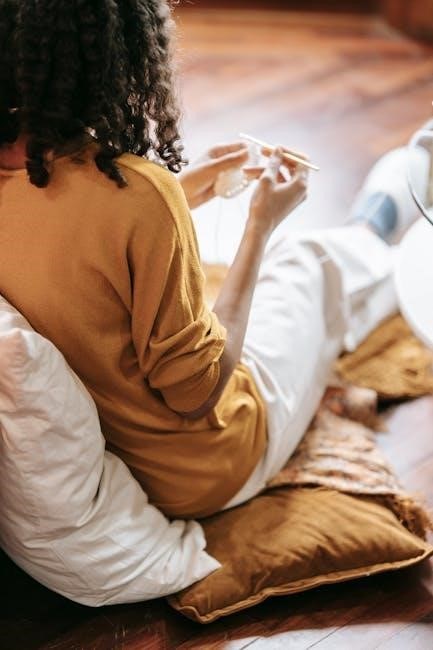
How to Read Crochet Patterns and Symbols
Understanding crochet patterns and symbols is crucial for accurately following stitch instructions and creating beautiful projects. This section helps you decode abbreviations and visual charts effectively, ensuring your crochet projects turn out as intended.
Understanding Crochet Abbreviations
Crochet patterns rely heavily on abbreviations to keep instructions concise. Common abbreviations include ch (chain), sc (single crochet), hdc (half double crochet), and dc (double crochet). Understanding these shorthand terms is essential for following patterns accurately. Special stitches like sl st (slip stitch) and st (stitch) are also frequently used. Always refer to the pattern’s abbreviation key for specific definitions. Mastery of these abbreviations enhances your ability to read and execute crochet instructions effectively, ensuring your projects are completed correctly and look professional.
Interpreting Crochet Symbol Charts
Crochet symbol charts visually represent stitches using icons and diagrams, making patterns easier to follow. Each symbol corresponds to a specific stitch, such as a circle for a single crochet or an X for a double crochet. These charts are especially helpful for visual learners and those unfamiliar with written instructions. To interpret them, start by identifying the key or legend provided with the chart. Pay attention to stitch orientation and row direction, as these details are crucial for maintaining the pattern’s integrity. Practice reading charts to improve your ability to translate symbols into stitches seamlessly.
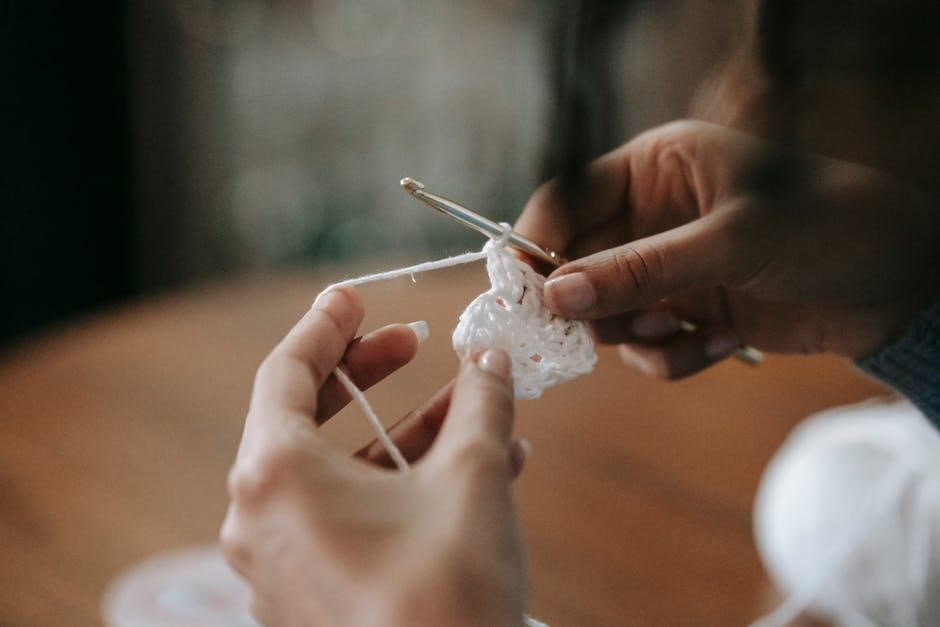
Resources for Crochet Stitches PDF
- Find free crochet patterns on websites like Moogly or The Crochet Crowd.
- Download official guides from yarn brands like Lion Brand or Bernat.
- Purchase detailed stitch dictionaries on platforms like Etsy.
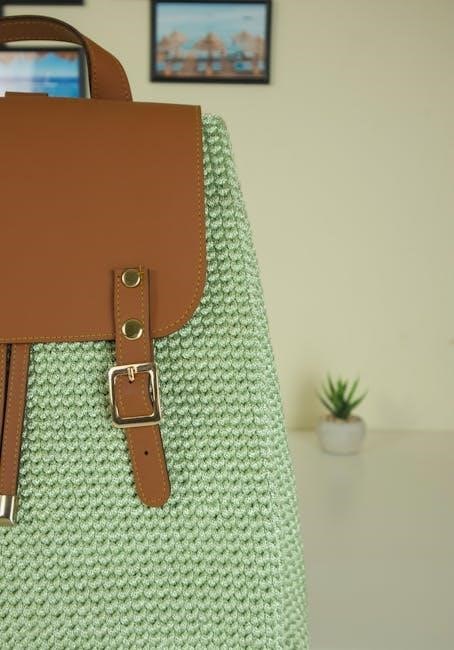
Free Crochet Stitches PDF Guides
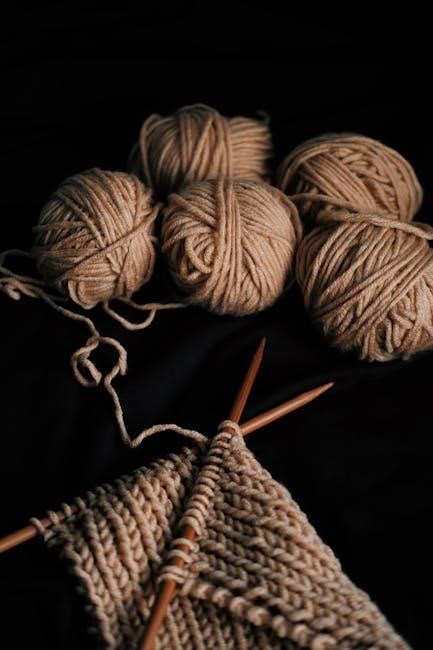
Free crochet stitches PDF guides are an excellent resource for beginners and experienced crocheters alike. Websites like Moogly, The Crochet Crowd, and Crochet Geek offer a wide variety of downloadable patterns. These guides often include step-by-step instructions, photos, and diagrams to help you master stitches. Many free PDFs focus on basic stitches, while others provide tutorials for specific projects. They are a great way to practice without spending money. You can also find stitch charts, tips, and troubleshooting advice in these guides, making them invaluable for improving your crochet skills.
Recommended Crochet Stitch Dictionary Books
Crochet stitch dictionaries are invaluable resources for crafters seeking comprehensive stitch guides. Popular titles like The Crochet Stitch Bible by Betty Barnden and Crochet World magazine’s stitch compendiums offer extensive libraries of stitches. These books provide clear instructions, photos, and step-by-step tutorials, making them perfect for all skill levels. Many are organized by stitch type or project, allowing easy navigation. While free PDFs are convenient, physical books often offer higher quality visuals and a tactile experience. Investing in a crochet stitch dictionary can enhance your stitch mastery and inspire creativity.
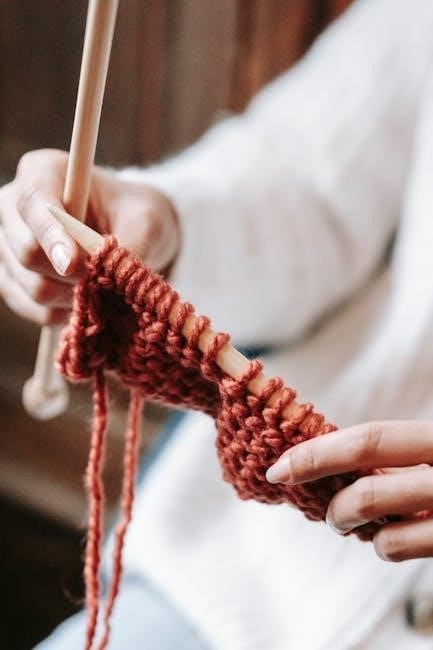
Step-by-Step Tutorials for Crochet Stitches
Step-by-step tutorials provide clear guidance for learning crochet stitches, often including photos and instructions. They cater to all skill levels, helping crafters master each stitch effortlessly.
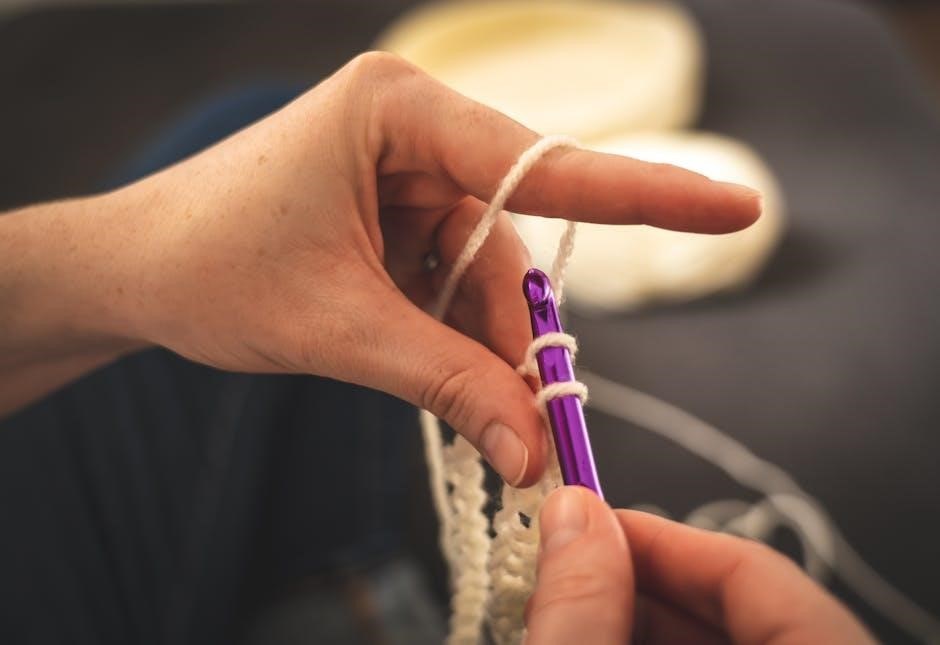
Video Tutorials for Visual Learners
Video tutorials are an excellent resource for visual learners, offering step-by-step demonstrations of crochet stitches. They provide real-time instruction, making it easier to understand complex patterns. Many tutorials include close-ups, slow-motion replays, and clear narration, ensuring learners can follow along effortlessly. Platforms like YouTube and crafting websites host a wide variety of tutorials, catering to all skill levels. Videos also allow learners to pause and rewind, giving them time to practice each stitch without feeling rushed. This format is particularly helpful for mastering intricate stitches or techniques that may be challenging to grasp from written instructions alone.
Practicing Stitches with Small Projects
Practicing crochet stitches with small projects is an effective way to master techniques without committing to large, time-consuming designs. Scarves, dishcloths, or coasters are ideal for honing skills like stitch consistency and tension. These projects allow you to focus on specific stitches, ensuring a strong foundation before moving to complex patterns. Additionally, small projects are motivating, as they provide a sense of accomplishment quickly. Using leftover yarn, you can create useful items while refining your craft. Starting with small projects also helps build confidence, making the transition to larger crochet endeavors feel more manageable and enjoyable.
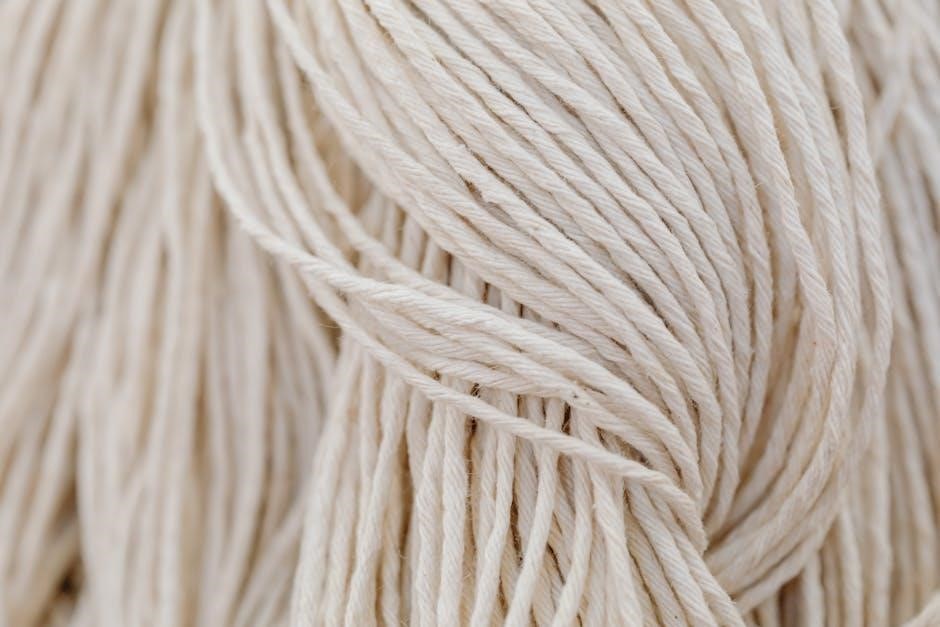
Troubleshooting Common Mistakes
Common crochet mistakes include uneven tension, miscounted stitches, and incorrect hook sizes. Regularly checking work and using stitch markers can help identify and fix errors early.
Counting Stitches Correctly
Accurate stitch counting is crucial for maintaining the integrity of crochet patterns. Start by counting each stitch in a row or round to ensure consistency. Use stitch markers to mark the beginning or end of a section, making it easier to track progress. For complex patterns, count stitches after each completed row or round to identify errors early. If a miscount occurs, unravel the work to the last correct point and restart. Regularly counting prevents discrepancies and ensures the finished project aligns with the intended design. Practice makes this process quicker and more efficient over time.
Fixing Uneven Tension
Maintaining even tension is key to professional-looking crochet projects. Uneven tension can cause misshapen designs or poor fit. To fix this, practice regularly to develop consistency. Check your gauge to ensure stitches are uniform. Use stitch markers to track your progress and maintain consistent stitch counts. Experiment with different hooks and yarns to find what works best for you. Always swatch before starting a project to assess and adjust your tension. Pay attention to how you hold the yarn and hook, and try to relax while crocheting. Blocking your finished project can also help even out the fabric for a polished finish.
Mastering crochet stitches opens a world of creativity and relaxation. With practice, patience, and the right resources, you can create beautiful, professional-quality projects. Happy crocheting!
Final Thoughts on Mastering Crochet Stitches
Mastering crochet stitches is a rewarding journey that combines creativity with technical skill. Consistency and patience are key to improving your craft. Whether you’re a beginner or an advanced crocheter, PDF guides provide invaluable support, offering clear instructions and visual aids. Experiment with different stitches to discover their unique textures and applications. Remember, practice is the foundation of mastery. Embrace the process, and soon you’ll create beautiful, professional-quality projects. Crochet not only produces lovely items but also fosters relaxation and a sense of accomplishment. Keep exploring, and let your creativity shine through every stitch!
Encouragement to Experiment and Create
Embrace creativity and freedom in crochet by experimenting with various stitches and patterns. Don’t be afraid to try new techniques or adapt existing ones to suit your style. Crochet stitches PDF guides offer a wealth of inspiration, but remember, the true magic lies in making projects your own. Combine stitches, explore colors, and pushes boundaries to create unique designs. Mistakes are part of the journey, often leading to exciting discoveries. Keep experimenting, and you’ll find endless joy in crafting something truly personalized. Crochet is not just a hobby—it’s an artistic expression!

